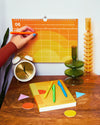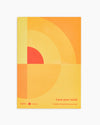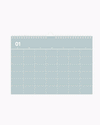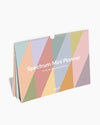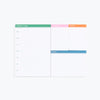
Stress has — unfortunately — become a constant companion for many of us. The weight of juggling work, family, social commitments, and personal goals can quickly take its toll on our mental and physical well-being. But fear not! There is a simple yet powerful tool that can help you maneuver through the chaos and find moments of calm amidst the storm: A planner.
Managing stress is essential for maintaining a healthy lifestyle. By getting your hands on a planner, you can take control of your days and reduce the overwhelming feelings that often come with a busy schedule.
We’ll guide you through the process of using a planner as a valuable resource for stress management, offering practical tips and strategies to help you find balance and peace in your daily life.
I’m Not Stressed…Am I?
Before getting into the specifics of using a planner to fight off stress, it's important to understand what stress is … and how it impacts us.
Stress is our body's natural response to challenges or demands, triggering a cascade of physiological and psychological reactions designed to help us cope with threats. While stress can be a useful motivator in small doses, prolonged or excessive stress can have harmful effects on our mental and physical health. I’m sure we can all nod our heads at that one!
Common sources of stress might be work deadlines, financial pressures, relationship issues, health concerns, and major life changes. Chronic stress can lead to a range of symptoms, such as anxiety, irritability, fatigue, muscle tension, and difficulty concentrating. Also, it can increase the risk of developing more serious conditions.
With this in mind, know that properly managing your stress is key to living a happy, healthy life!
What Are the Benefits of Using a Planner?
When looking to manage stress and stay organized, a planner can be your best friend. The benefits of adding a planner to your daily routine are extensive — and can significantly impact your well-being.
A planner lets you gather all your tasks, appointments, and commitments in one central location, helping you stay organized and avoid feeling overwhelmed by scattered thoughts and responsibilities. You can also set specific time blocks for different tasks and activities, ensuring that you make the most of your day and prioritize what truly matters.
Seeing your plans laid out visually in a planner can provide a sense of structure and clarity, which can lessen anxiety about forgetting important deadlines or tasks. Setting goals and breaking them down into actionable steps — and tracking your progress in a planner — can make you feel more productive, freeing up time to focus on the little things in life!
How To Choose the Right Planner
Selecting the right planner that suits your lifestyle and preferences is important to keep stress out of sight.
Here are some of our helpful tips to guide you in choosing the perfect planner:
- Consider Your Needs: Reflect on your scheduling habits, whether you prefer digital or paper tools, and the specific features that would benefit you the most, such as goal-setting pages, monthly calendars, or habit trackers.
- Evaluate Formats: Explore different planner formats, including daily, weekly, or monthly layouts — as well as hybrid options that combine digital and paper elements — to find what aligns best with your planning style.
- Customization: Look for planners that offer customization options, such as refillable pages, interchangeable covers, or the ability to add personal touches to make your planner truly your own.
When you choose a planner that resonates with you and meets your unique needs, you can set yourself up for success and create a more balanced and fulfilling life!
Getting Started With Your Planner
Now that you know the benefits of using a planner and have chosen the right one, it's time to get started! You’ll want to set it up in a way that helps you stay organized and reduce stress.
Make your planner your own by adding personal touches, inspirational quotes, or stickers to make it visually appealing and engaging. You can also divide your planner into sections for different aspects of your life, such as work, personal, health, and goals. This ensures that everything is well-organized and easy to access!
Next, you can try establishing essential pages in your planner, such as a yearly overview, monthly calendars, weekly spreads, goal-setting pages, and habit trackers. Then, make sure to incorporate regular planning sessions into your routine — whether it's at the beginning of the day, week, or month — to review your progress, set new goals, and adjust your plans as needed.
What Are Some Tips on Organizing Your Planner?
So, you bought a planner to stay organized. Great! Now … how exactly can you organize it?
Breaking down your goals and responsibilities into manageable chunks can relieve stress. Here are strategies for optimizing task organization and priority setting in your planner:
- Task Breakdown: Divide larger tasks into smaller, actionable steps to make them more manageable and easier to tackle.
- Set Priorities: Use methods such as color-coding, numbering, or categorizing tasks based on urgency or importance to prioritize effectively.
- Time Blocking: Allocate specific time blocks in your planner for different tasks, meetings, and activities to create a structured schedule that maximizes productivity and minimizes distractions.
- Realistic Scheduling: Be realistic about the time needed to complete tasks and avoid overloading your schedule, allowing for flexibility and buffer time to accommodate unexpected delays or changes.
Some Final Tips on Utilizing Your Planner
To fully enjoy the benefits of using a planner, you need to make sure you’re using it properly!
Modern planners offer plenty of tools and functions that can enhance your planning experience — and contribute to your well-being. Here are ways to make the most of these features:
- Habit Tracking: Add habit tracking pages in your planner to monitor your daily routines, behaviors, and self-care activities, helping you cultivate positive habits and maintain a healthy lifestyle.
- Reflective Journaling: Dedicate space in your planner for reflection, gratitude journaling, or mindfulness exercises. The goal here is to promote self-awareness, reduce stress, and enhance your mental clarity.
- Self-Care Activities: Integrate self-care practices into your daily planning routine, scheduling time for activities that promote relaxation and rejuvenation.
Use these tips to create a holistic approach to stress management that nourishes your mind, body, and soul!
The Takeaway
By incorporating practices of celebration and gratitude into your planning routine, you can create a positive mindset and embrace a more fulfilling and balanced life.
At Poketo, one of our goals is to help you live vibrantly and creatively. We offer tools to inspire creativity and organization in managing stress.
Discover artful everyday solutions with our colorful and practical products today!
Sources:
Yes, Stress Can Hurt Your Heart: 3 Things to Know | Yale Medicine
18 Signs That Stress May Be Getting to You | Psychology Today
5 Ways to Set More Achievable Goals | Harvard Business Review
The Neuroscience of Gratitude and Effects on the Brain | PositivePscyhology



















































